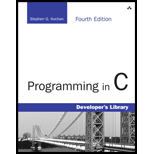
Concept explainers
Type in and run the five programs presented in this chapter. Compare the output produced by each
Data types:
The variables use data-type during their declaration.
- The data-type is used to determine the size of memory allocated. Here, the compiler allots the memory.
- All data-type needs different size of memory.
Some of the data-types are:
- Integer
- Boolean
- Character
- Double
- Floating point
Integer data type:
The “int” is a keyword for floating point datatype.
It is a number and it cannot have a fractional part. It may be a positive value, a negative value or zero.
- Integer data type uses 4 bytes of memory.
Boolean data type:
The “_Bool” is a keyword for floating point datatype.
- A Boolean data type is a data type that represents the two values.
- The two values are “true” and “false”.
Character data type:
A “char” is a keyword for character data type.
- Character data type stores the characters.
- Character data type requires one byte memory space.
- The character should always place inside the single quotes.
Double data type:
The “double” is a keyword for floating point datatype.
The size of the double variable contains 8 bytes.
It can represent real numbers, minus and decimal numbers.
Floating point data type:
The “float” is a keyword for floating point datatype.
- The data type “float” stores single precision floating point decimal values.
- The memory space used for float is “four” bytes.
Explanation of Solution
Program:
Consider the five programs presented in the given chapter.
Program 3.1:
//include the header file
#include <stdio.h>
//definition of main method
int main (void)
{
/*declare and initialize the value to the required variables*/
int integerVar = 100;
float floatingVar = 331.79;
double doubleVar = 8.44e+11;
char charVar = 'W';
_Bool boolVar = 0;
//display the result
printf ("integerVar = %i\n", integerVar);
printf ("floatingVar = %f\n", floatingVar);
printf ("doubleVar = %e\n", doubleVar);
printf ("doubleVar = %g\n", integerVar);
printf ("charVar = %c\n", charVar);
printf ("boolVar = %i\n", boolVar);
//return statement
return 0;
}
Explanation:
In the above program, declare the variables with different data types and assign values to that variables. Then display the values using “printf” function on the output screen.
Sample Output for program 3.1:
integerVar = 100
floatingVar = 331.790009
doubleVar = 8.440000e+11
doubleVar = 8.44e+11
charVar = W
boolVar = 0
Want to see more full solutions like this?
Additional Engineering Textbook Solutions
Starting Out with Python (4th Edition)
Web Development and Design Foundations with HTML5 (8th Edition)
Database Concepts (8th Edition)
Elementary Surveying: An Introduction To Geomatics (15th Edition)
Java How to Program, Early Objects (11th Edition) (Deitel: How to Program)
Starting Out with Programming Logic and Design (5th Edition) (What's New in Computer Science)
- "Do not use AI tools. Solve the problem by hand on paper only and upload a photo of your handwritten solution."arrow_forward"Do not use AI tools. Solve the problem by hand on paper only and upload a photo of your handwritten solution."arrow_forward"Do not use AI tools. Solve the problem by hand on paper only and upload a photo of your handwritten solution."arrow_forward
- "Do not use AI tools. Solve the problem by hand on paper only and upload a photo of your handwritten solution."arrow_forwardSolve this "Do not use AI tools. Solve the problem by hand on paper only and upload a photo of your handwritten solution."arrow_forward"Do not use AI tools. Solve the problem by hand on paper only and upload a photo of your handwritten solution."arrow_forward
- "Do not use AI tools. Solve the problem by hand on paper only and upload a photo of your handwritten solution."arrow_forwardSpecifications: Part-1Part-1: DescriptionIn this part of the lab you will build a single operation ALU. This ALU will implement a bitwise left rotation. Forthis lab assignment you are not allowed to use Digital's Arithmetic components.IF YOU ARE FOUND USING THEM, YOU WILL RECEIVE A ZERO FOR LAB2!The ALU you will be implementing consists of two 4-bit inputs (named inA and inB) and one 4-bit output (named out). Your ALU must rotate the bits in inA by the amount given by inB (i.e. 0-15).Part-1: User InterfaceYou are provided an interface file lab2_part1.dig; start Part-1 from this file.NOTE: You are not permitted to edit the content inside the dotted lines rectangle. Part-1: ExampleIn the figure above, the input values that we have selected to test are inA = {inA_3, inA_2, inA_1, inA_0} = {0, 1, 0,0} and inB = {inB_3, inB_2, inB_1, inB_0} = {0, 0, 1, 0}. Therefore, we must rotate the bus 0100 bitwise left by00102, or 2 in base 10, to get {0, 0, 0, 1}. Please note that a rotation left is…arrow_forwardSolve this "Do not use AI tools. Solve the problem by hand on paper only and upload a photo of your handwritten solution."arrow_forward
- Solve this "Do not use AI tools. Solve the problem by hand on paper only and upload a photo of your handwritten solution."arrow_forward"Do not use AI tools. Solve the problem by hand on paper only and upload a photo of your handwritten solution."arrow_forwardSolve this "Do not use AI tools. Solve the problem by hand on paper only and upload a photo of your handwritten solution."arrow_forward
 C++ for Engineers and ScientistsComputer ScienceISBN:9781133187844Author:Bronson, Gary J.Publisher:Course Technology Ptr
C++ for Engineers and ScientistsComputer ScienceISBN:9781133187844Author:Bronson, Gary J.Publisher:Course Technology Ptr C++ Programming: From Problem Analysis to Program...Computer ScienceISBN:9781337102087Author:D. S. MalikPublisher:Cengage Learning
C++ Programming: From Problem Analysis to Program...Computer ScienceISBN:9781337102087Author:D. S. MalikPublisher:Cengage Learning EBK JAVA PROGRAMMINGComputer ScienceISBN:9781337671385Author:FARRELLPublisher:CENGAGE LEARNING - CONSIGNMENT
EBK JAVA PROGRAMMINGComputer ScienceISBN:9781337671385Author:FARRELLPublisher:CENGAGE LEARNING - CONSIGNMENT- COMPREHENSIVE MICROSOFT OFFICE 365 EXCEComputer ScienceISBN:9780357392676Author:FREUND, StevenPublisher:CENGAGE LProgramming Logic & Design ComprehensiveComputer ScienceISBN:9781337669405Author:FARRELLPublisher:CengageNp Ms Office 365/Excel 2016 I NtermedComputer ScienceISBN:9781337508841Author:CareyPublisher:Cengage





